Category: cooking

From My Kitchen to Yours: Comfort Food, Conversation and Living History Farms
Ever get an email that jumps out at you? It happened me to last July when one arrived with the subject line “Greetings from Living History Farms.” It was from my friend, Jim Dietz-Kilen, a former classmate from the Ag-Urban Leadership Initiative, and his note intrigued me.
“I have an idea for your consideration,” wrote Jim, who is the vice president of development for Living History Farms (LHF). “We are planning our annual gala, Farmstasia. We try to put together unique experience packages for our auction, with emphasis on agriculture/rural life and Iowa history. My idea is to build a package around you. While I am very open to other ideas, I wanted to run the following request by you:
• Would you be willing to donate a signed book? Any of your books would be wonderful, but I am partial to the Culinary History of Iowa.
• Would you also be willing to host a family at your farm to show them a bit of what your lives are like?
• Finally, would you be willing to serve these guests a meal selected from your book?
I know this is asking a lot, Darcy, but I have learned that you never know until you ask. And, as Wayne Gretzky said, ‘Every shot you don’t take is a miss.'”
By this point, I was already brainstorming menu ideas.
I’m a big fan of LHF, which welcomes between 100,000 and 110,000 each year. This interactive, 500-acre outdoor museum that tells the amazing 300+ year story of how Iowans transformed the fertile prairies of the Midwest into the most productive farmland in the world. As I wrote in this blog for Latham Hi-Tech Seeds, I love how LHF encourages people of all ages to explore Iowa’s rural heritage, including the 1700 Ioway village, the 1850 pioneer farm, the 1875 town of Walnut Hill and the 1900 horse-powered farm.
“All proceeds from Farmstasia go to keep fees low for our education programs, helping make it possible for kids from across the state to come here for school visits and participate in other educational experiences,” Jim continued.
Jim knows what is near and dear to my heart. Iowa agriculture. Books. Classic Iowa farm cooking. LHF. Giving back to the community. Without hesitating, I said yes.

Living History Farms Iowa
Cookstoves, corncobs and storytelling
LHF came into my life in a big way in the summer of 1995, when my college internship led me to the 1900 farm, Flynn mansion and veterinary clinic, where I served as a historical interpreter and looked the part in my Victorian-inspired dresses and bonnets.
That summer changed my life in so many ways. I met my husband through this experience. I also expanded my cooking skills. By the end of the summer, I knew how to light a cookstove with crumpled newspapers and corncobs. I could make homemade noodles with no problem. I could bake cookies in an oven with no temperature gauge, other than the feel of the heat on your hand. I could milk a Jersey cow by hand and churn the cream into butter. I could plan a meal and feed a threshing crew. I could even run a treadle sewing machine and sew my own apron.
Looking back, I was a prepper in training who can live off the grid if I have to.
While I don’t use all those skills today, some have served me well for years, especially the cooking skills, the historical knowledge I gained and the storytelling skills I learned. As a historical interpreter, I was not only working in the kitchen of the 1900 farm fixing a meal, but I interacted with guests. As I shared stories about Iowa farm life in the early 1900s, I learned the importance of listening. I’m still embarrassed when I misunderstood one guest who asked, “Is that a coal stove?” but I heard him say, “Is that a cold stove?” so I replied, “No, it’s a warm one!”
Planning a memorable menu
I was thinking of those experiences last Saturday, February 16, when I delivered on my promise to provide the Farmtasia winning bidders with an authentic Iowa farm meal inspired by my book. I had actually started cooking the night before and then got up early on Saturday morning so I’d get everything done on schedule and have time to visit with my guests.
They pulled in the driveway at my family’s Century Farm near Lake City right on time. It was an honor to host Dave Bubeck, a corn breeder at Corteva Agriscience™ in Johnston; his wife, Denise; and their friends Ben and Michelle Parlett, who also live in the Des Moines area. As we gathered around the table at noon, I served:
• Garden Vegetable Soup
• Homemade Beer Bread
• Iowa Ham Balls
• Glazed Meat Loaf
• Garlic Cheesy Smashed Potatoes
• Relish tray and coleslaw salad
• Homemade apple crisp with Haralson apples grown on our farm
There was something magical happened as we sat in that 100+plus-year-old kitchen, talking farming, food, travel and LHF. Seems like we covered everything, from how to talk about GMOs to what it’s like subscribing to a meal delivery service. Two and a half hours later, when my guests departed, we all agreed it was a great experience—the kind of story-worthy experience that LHF inspires. Even better, we’re staying in touch through social media and my e-newsletter.
And to think it all started with a simple email and a spirit of service. It reminds me of this quote from Orison Swett Marden, who founded SUCCESS magazine in 1897.
“We must give more in order to get more. It is the generous giving of ourselves that produces the generous harvest.”
Let’s get cooking
If you’d like to create a taste of our classic Iowa farm dinner, here are some of my favorite recipes:
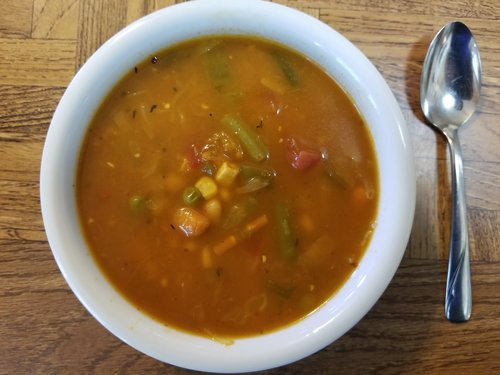
Hearty Homemade Vegetable Soup
Hearty Garden Vegetable Soup
I shared this tasty recipe in one my my monthly diary entries in 2018 for the Iowa Food and Family Project.
1 tablespoon olive oil
8 medium carrots, sliced
3 large onions, chopped
5 celery ribs, chopped
1 large green pepper, seeded and chopped
1 garlic clove, minced
2 cups chopped cabbage
2 cups frozen cut green beans (about 8 ounces)
2 cups frozen peas (about 8 ounces)
1 can (15 ounces) corn, or 2 cups fresh sweet corn
1 can (28 ounces) diced tomatoes, undrained
2 bay leaves
2 teaspoons chicken bouillon granules
1-1/2 teaspoons dried parsley flakes
1 tablespoon seasoning salt
1 teaspoon dried marjoram
1 teaspoon dried thyme
1/2 teaspoon dried basil
1/2 teaspoon pepper
7 cups water
1 teaspoon Worcestershire sauce
4 cups V8 vegetable juice
In a stockpot, heat oil over medium-high heat; sauté carrots, onions, celery and green pepper until crisp-tender. Add garlic; cook and stir 1 minute. Stir in remaining ingredients; bring to a boil. Reduce heat; simmer, covered, until vegetables are tender, 1 to 1-1/2 hours. Remove bay leaves.
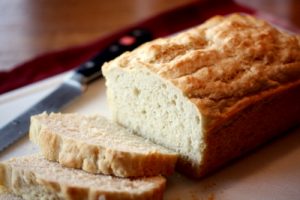
Best Beer Bread
Best Beer Bread
2 cups self-rising flour
2 1 / 2 tablespoons sugar
1 12-ounce can of beer
Mix all ingredients together. Pour batter into a greased loaf pan. Bake at 350 degrees for 45 to 50 minutes.
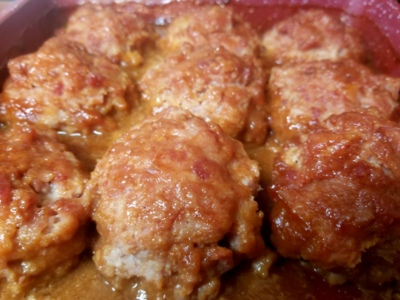
Iowa Ham Balls
Iowa Ham Balls
This tasty, classic recipe comes from my friend Val Plagge, who is a wonderful farm cook.
2.5 pounds ham
2 eggs
1 1/2 cups graham cracker crumbs
1 cup milk
1 can tomato soup
3/4 cup brown sugar
1/4 cup white vinegar
1 teaspoon ground mustard
With a food processor, grind ham into small, chopped pieces (or buy ham loaf mix from local grocery store or butcher. This mix usually contains ham and ground pork, and sometimes ground beef, too). Add eggs, graham cracker crumbs and milk. Mix together with your hands, and form fist-sized ham balls. (If the mixture seems a little dry, add 1/4 cup of milk at a time, up to 1 1/2 cups of milk total.) Place ham balls in a greased 9-inch by 13-inch pan. They fit nicely three across and five down.
Mix soup, brown sugar, vinegar and mustard until smooth. Drizzle glaze over the ham balls for the classic ham ball sauce. (Or, if you’re in a rush, drizzle your favorite barbecue sauce over the ham balls.) Bake at 350 Fahrenheit for 1 hour. Yield: 13-15 ham balls
Note: These ham balls freeze well and can be warmed up in a slow cooker, if desired. Ham balls are the perfect Iowa potluck treat!
Cheesy Garlic Mashers
Taking a twist on classic mashed potatoes, this recipe is loaded with flavor and offers the perfect comfort food.
Red Bliss or Yukon gold potatoes (use about one potato per person, although this will depend on the size of the potatoes)
6 garlic cloves (can use less, if you prefer)
Butter, 1 / 2 stick
Cream (use enough to give mashed potatoes the consistency you prefer)
1 carton sour cream (can substitute one carton of chip dip, if you prefer)
1 / 2 cup to 1 cup of Cheddar cheese
Seasoning salt and pepper, to taste
Chives, chopped
Bacon, 2 to 3 slices, fried
Boil potatoes in salted water with peeled, whole garlic cloves. When potatoes are done cooking, drain potatoes and garlic and place in a bowl with butter and cream. Mash together. Add more cream, if necessary, to achieve the consistency you prefer. Mix in sour cream and cheddar cheese. Season to taste with seasoning salt and pepper. Garnish with chopped chives and real bacon bits.
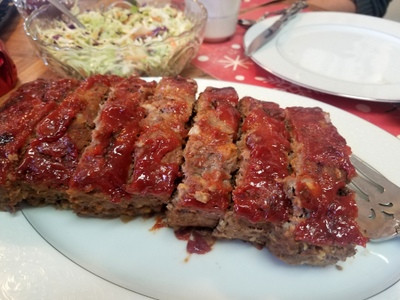
Glazed Meatloaf
Darcy’s Best Brown-Sugar Meatloaf
This recipe was inspired by the meatloaf that caterers prepared on the set in Iowa for the filming for “The Bridges of Madison County.” This is the only meatloaf recipe you’ll ever need!
1 pound ground beef
1 pound ground pork or ground turkey
1 cup herb-seasoned stuffing mix
1 onion, chopped
1 teaspoon salt
1/2 teaspoon freshly-ground pepper
1 teaspoon nutmeg
2 large eggs, lightly beaten
3 / 4 cup milk
2 tablespoons barbecue sauce
1 / 4 cup ketchup
2 tablespoons brown sugar
1 teaspoon dry mustard
Combine beef, pork or turkey, stuffing mix, onion, salt, pepper and nutmeg. In a separate bowl, beat eggs, milk, and barbecue sauce. Add to meat mixture, mixing well. Press into a meatloaf pan sprayed with non-stick cooking spray.
Combine ketchup, brown sugar, and mustard; spread over top of meat loaf. Bake, uncovered, at 350 degrees F for 1 hour and 30 minutes or until a thermometer inserted in the center of the loaf registers 160 degrees. Yield: 6 servings
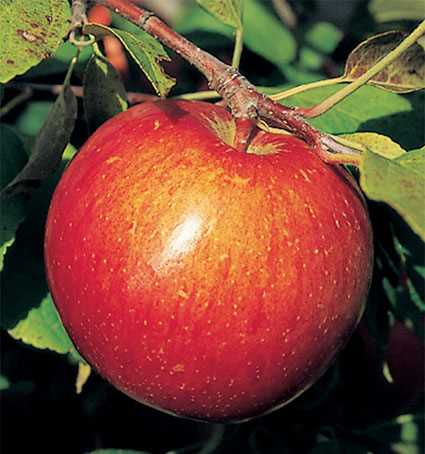
Haralson apple photo from Jung Seed
Farm-Fresh Apple Crisp with Whipped Cream
If you have the chance to visit a local apple orchard, pick up some Haralson apples, if they are available. We grow Haralsons on our farm, and their sweet-tart flavor works perfectly in apple pies and apple crisps.
Fruit Filling:
6 baking apples, peeled, cored and cut into wedges
1 tablespoon lemon juice
1 / 2 cup sugar
2 tablespoons flour (maybe need more, depending on how juicy the apples are)
Crumb topping:
1 1 / 4 cups flour
1 / 2 cup rolled oats
1 / 2 cup light brown sugar
1 / 2 teaspoon ground cinnamon
1 / 4 teaspoon salt
12 tablespoons butter (1 1/2 sticks), cut into small pieces
Preheat the oven to 350 degrees Fahrenheit.
For the fruit filling:
In a large mixing bowl, toss together the apples, lemon juice, sugar, and flour. Pour the apple mixture into a buttered 2-quart baking dish and set aside.
For the topping:
In a large mixing bowl, mix the flour, rolled oats, brown sugar, cinnamon, and salt. With a pastry blender, work the butter into the flour mixture just until mixture comes together and pea-sized clumps form.
Sprinkle the topping evenly over the fruit. Bake the apple crisp until the fruit is bubbling and the topping is golden brown and crisp, about 45 minutes.
Serve the crisp warm with vanilla bean ice cream or fresh whipped cream, if desired.
To make whipped cream, pour 1 cup of whipping cream into metal bowl on stand mixer. (Chill the bowl and whip attachment in the refrigerator first.) Begin mixing on high speed. As the cream starts to form into whipped cream, add powdered sugar a tablespoon at a time, until you achieve the sweetness you desire. Continue mixing on high until the mixture looks like thick whipped cream. Serve with apple crisp.
Want more?
Thanks for stopping by. I invite you to read more of my blog posts if you value intriguing Iowa stories and history, along with Iowa food, agriculture updates, recipes and tips to make you a better communicator.
If you like what you see and want to be notified when I post new stories, be sure to click on the “subscribe to blog updates/newsletter” button at the top of this page, or click here. Feel free to share this with friends and colleagues who might be interested, too.
Also, if you or someone you know could use my writing services (I’m not only Iowa’s storyteller, but a professionally-trained journalist with 20 years of experience), let’s talk. I work with businesses and organizations within Iowa and across the country to unleash the power of great storytelling to define their brand and connect with their audience through clear, compelling blog posts, articles, news releases, feature stories, newsletter articles, social media, video scripts, and photography. Learn more at www.darcymaulsby.com, or e-mail me at yettergirl@yahoo.com.
If you’re hungry for more stories of Iowa history, check out my top-selling “Culinary History of Iowa: Sweet Corn, Pork Tenderloins, Maid-Rites and More” book from The History Press. Also take a look at my latest book, “Dallas County,” and my Calhoun County” book from Arcadia Publishing. Both are filled with vintage photos and compelling stories that showcase he history of small-town and rural Iowa. Order your signed copies today! Iowa postcards are available in my online store, too.
Let’s stay in touch. I’m at darcy@darcymaulsby.com, and yettergirl@yahoo.com.
Talk to you soon!
Darcy
@Copyright 2019 Darcy Maulsby & Co. Blog posts may only be reprinted with permission from Darcy Maulsby.

What To Do When the Travel Channel Calls
Just how far can things go when you tell agriculture’s story? Turns out your message might just resonate with a national audience.
For me, it all started with a simple email on June 15. I was checking inbox that morning when I saw a note with the subject line “Bizarre Foods: Delicious Destinations– Researching Iowa.”
Could this be THE Delicious Destinations show on the Travel Channel? The channel filled with some of the best food and travel stories anywhere on TV? The stuff I love watching on the weekends when I’m actually home and have a few hours to relax?
Yes, yes and yes.
The note came from Lauren Shaffer, a researcher with “Bizarre Foods Delicious Destinations.”
“Each of our episodes feature a different city and the edible icons that make it a delicious destination,” wrote Lauren, who included an online link to the show. “We’re looking at doing a Des Moines episode in our upcoming season, and I’d love to get your opinion on what you think are the must-eats that make Des Moines, and Iowa in general, so special. Right now, we’re looking at sweet corn, pork tenderloin and Maid-Rite sandwiches, to name a few. I’ve downloaded your book, A Culinary History of Iowa, on my Kindle, and I am excited to get started on it!”
Rule number one when you receive a media request—respond as quickly as possible.
Within minutes, I replied to Laruen that I would love to help. We set up a time to chat over the phone within the week. During our conversation, which lasted almost an hour, I had a great time sharing my thoughts on what makes Iowa’s culinary history unique, how our foods are tied to our rich agricultural heritage and what I thought were some iconic Iowa foods that should be part of the show (from breaded pork tenderloins to Dutch letters to Maid-Rites to sweet corn).
On July 12, I received a new email with the subject line “Food Expert – Travel Channel Food Show – Iowa.” This one came from Lauren’s colleague Stacie Buszmann, segment producer with Tremendous! Entertainment, which produces Delicious Destinations. (I love how the company says it specializes in telling great stories through passionate characters who want to change the world.)
Stacie asked if she could visit with me over the phone to get more input on the Iowa episode. We talked about not only potential stories, but logistics. What would make sense, given the timing of the filming (four days in August to coincide with the great 2018 Iowa State Fair) and how the TV crew would be based in the Des Moines area during their time in Iowa?
Then came the biggest surprise. “Would you be willing to be our food expert?” Stacie asked. “We’d love for you to meet the crew for your interview at The Corn Stand in the Varied Industries Building at the Iowa State Fair on Monday, August 13.”
I didn’t think twice. “Yes!”
What an honor to help share the amazing story of Iowa agriculture and our unique food culture. Before we filmed the segment that hot afternoon around 5:30 p.m., I had the chance to visit with writer Tiffany Thompson, who lives in Los Angeles.
Tiffany and her fellow TV crew members not only hail from across the country, but around the world. They also travel the globe as they gather stories to share through Delicious Destinations.
“I wish everyone had the chance to see the world the way we do,” Tiffany said. “You realize quickly how blessed we are, and you also see that people everywhere want the same things, including good food.”
Yes, I thought. I wish more people could experience rural Iowa the way I do. We are blessed by the abundance of good land and good food here. We are blessed by farmers like my neighbors and my family who strive to be as productive as possible while caring the environment and the community. Most of all, we share this remarkable culture of agriculture—something many people are far removed from today.
It’s a story worthy sharing. That’s why I’m excited to learn that episodes of Bizarre Foods Delicious Destinations have a long lifespan, sometimes being broadcast multiple times for up to 10 years after they’ve been produced. (Watch for the Iowa episode sometime in 2019).
There’s a reason why stories like this endure. “Food is a powerful way to bring people together,” Tiffany said.
I couldn’t agree more.
Want more?
Thanks for stopping by. I invite you to read more of my blog posts if you value intriguing Iowa stories and history, along with Iowa food, agriculture updates, recipes and tips to make you a better communicator.
If you like what you see and want to be notified when I post new stories, be sure to click on the “subscribe to blog updates/newsletter” button at the top of this page, or click here. Feel free to share this with friends and colleagues who might be interested, too.
Also, if you or someone you know could use my writing services (I’m not only Iowa’s storyteller, but a professionally-trained journalist with 20 years of experience), let’s talk. I work with businesses and organizations within Iowa and across the country to unleash the power of great storytelling to define their brand and connect with their audience through clear, compelling blog posts, articles, news releases, feature stories, newsletter articles, social media, video scripts, and photography. Learn more at www.darcymaulsby.com, or e-mail me at yettergirl@yahoo.com.
If you’re hungry for more stories of Iowa history, check out my top-selling “Culinary History of Iowa: Sweet Corn, Pork Tenderloins, Maid-Rites and More” book from The History Press. Also take a look at my latest book, “Dallas County,” and my Calhoun County” book from Arcadia Publishing. Both are filled with vintage photos and compelling stories that showcase he history of small-town and rural Iowa. Order your signed copies today! Iowa postcards are available in my online store, too.
Let’s stay in touch. I’m at darcy@darcymaulsby.com, and yettergirl@yahoo.com.
Talk to you soon!
Darcy
@Copyright 2019 Darcy Maulsby & Co. Blog posts may only be reprinted with permission from Darcy Maulsby.
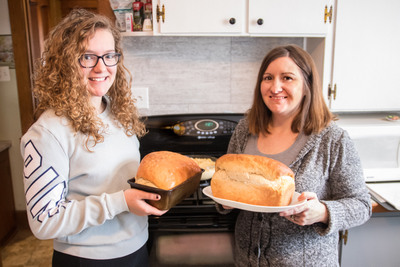
Baking is for Sharing: Best Bread, Grandma Ruby’s Cookies and Other Iowa Favorites
One of the most fun projects I write for clients is the Farm Cook feature that appears in Farm News. I get to meet interesting people in my area and fine-tune my culinary skills, thanks to the wonderful recipes and handy cooking tips they share. Here’s my latest Farm Cook feature with my new friend, Valerie. Enjoy!
What is it about baking that’s so intensely satisfying? Is it the rich aromas, the magic of creating something so comforting, or the opportunity to make family mealtime a priority? It’s all the above for Valerie Stuhrenberg of Pocahontas.
“I’ve always liked to cook and bake,” said Stuhrenberg, a Pocahontas native and registered nurse who works at Stewart Memorial Community Hospital in Lake City. “It runs in the family.”
Stuhrenberg, the youngest of 10 children, credits her father, Keith, with inspiring her love of cooking and baking. While his famous homemade cinnamon rolls were the hit of the neighborhood, Stuhrenberg especially loved his homemade pancakes.
“Dad learned to cook from his Grandma Stanton, who lived in Peterson,” said Stuhrenberg, who noted that he honed his culinary skills in various restaurants, including the Green Lantern Steak House in Decatur, Nebraska, and a restaurant he ran in Rockwell City.
Like many good cooks, Stuhrenberg’s father came from a line of home cooks who didn’t rely much, if at all, on recipes. This tradition of experimenting in the kitchen was passed on to Stuhrenberg, who’s not afraid of a challenge. When a friend who moved to Iowa asked if Stuhrenberg could make her a Kentucky Jam Cake, she wasn’t daunted.
“I said sure, even though I’d never heard of it before,” said Stuhrenberg, who had no trouble making this frosted spice cake.
Stuhrenberg has passed along her love of baking to her daughter, Ally, 14, a freshman at Pocahontas Area High School. When she was a member of the Guys and Gals of Grant 4-H Club, Ally Stuhrenberg’s baked goods, including Kentucky Jam Cake, won top honors at both the Pocahontas County Fair and the Iowa State Fair.
There’s always something homemade and good to eat at home, added Ally Stuhrenberg, who helps cook for her dad, Bob, and younger brother, Trevor, when her mother is working. Home cooking abounds at family get-togethers, added Valerie Stuhrenberg, who noted that all her siblings can cook, and one brother is a chef in the Omaha area. “It makes holidays really fun.”
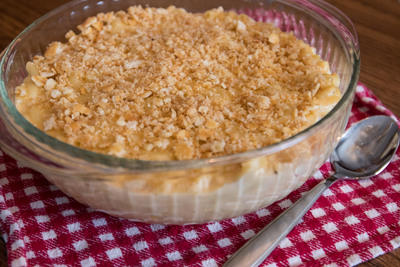
Homemade Baked Mac and Cheese
Baked Macaroni & Cheese
8 ounces elbow macaroni (2 cups dry macaroni)
4 tablespoons butter
4 tablespoons flour
1 / 2 teaspoon salt
Black pepper, to taste
1 / 4 teaspoon nutmeg
1 cup milk
1 cup cream or evaporated milk
2 cups cheddar cheese, shredded
Crumb topping:
Ritz crackers, crushed
Butter
Preheat oven to 400 degrees Fahrenheit. Cook macaroni, and set aside. Melt butter in a sauce pan. Whisk in the flour, salt, black pepper and nutmeg. Add milk and cream (or evaporated milk); boil for 2 minutes, stirring constantly. Turn down the heat, and simmer mixture for 10 minutes, stirring occasionally. Remove from heat.
Add cheese to cream sauce mixture. Combine with cooked elbow macaroni. Pour into baking dish and bake for 10 minutes. As the casserole bakes, combine crushed Ritz crackers and melted butter. (Stuhrenberg doesn’t measure exactly amounts.) After 10 minutes of baking, remove casserole from oven, sprinkle crumb topping mixture over the top, and bake the casserole for 10 more minutes. Remove from oven and serve.
(Note: all the ingredients, other than the crumb topping, can be combined and then frozen so the casserole can be baked later.)
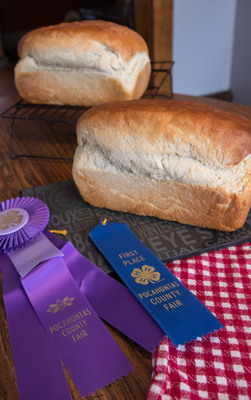
Award-winning Best Bread
Best Bread
4 1 / 2 teaspoons (2 packages) yeast
3 / 4 cup warm water
3 tablespoons soft butter
1 / 4 cup granulated sugar
1 tablespoon salt
2 2 / 3 cups additional water
9 to 10 cups flour
Put yeast and 3 / 4 cup warm water in mixer to proof for 5 minutes. Add butter, sugar, salt and the additional 2 2 / 3 cups water. Slowly add 5 cups of flour. Then add the remaining flour until a dough ball forms. Knead the dough for 5 to 10 minutes in mixer. (You may need to knead the dough in two batches.)
Put dough into a greased bowl, and let dough rise for 1 hour.
Punch down the dough, and separate the dough into two halves for two loaves of bread. Roll the dough out into two 12-inch by 12-inch squares. Then roll each square into the shape of a loaf of bread, tightly tucking in the seams and ends.
Place loaves in greased bread pans, and allow the dough to rise for 1 hour. Bake loaves for 15 minutes in an oven preheated to 425 degrees Fahrenheit. Cover loaves with aluminum foil, and bake 15 minutes more. Remove loaves from oven and cool on wire racks.
Grandma Ruby’s Cookies
This recipe came from Ruby Otto, a farm wife from the Plover area. “She would always make a big batch of these so she could take some to the field at planting and harvest and keep some in the freezer,” Valerie Stuhrenberg said.
2 cups granulated sugar
4 cups brown sugar
4 cups shortening
8 medium eggs
4 teaspoons vanilla
4 teaspoons baking soda
9 to 10 cups flour
2 teaspoons salt
24 ounces chocolate chips
24 ounces raisins
Preheat oven to 350 degrees Fahrenheit. Use an electric mixer to cream together the white sugar, brown sugar and shortening until smooth. Beat in the eggs one at a time, then stir in vanilla. In a separate bowl, combine the baking soda, salt and flour. Combine liquid mixture with dry mixture. Add chocolate chips and raisins to the batter.
Drop by large spoonfuls onto ungreased cookie sheets. Bake for about 10 to 13 minutes in the preheated oven, or until cookie edges are nicely browned. (More baking time creates a crisper cookie, while less baking time creates a chewier cookie.)
Kentucky Jam Cake with Caramel Frosting
Kentucky Jam Cake is a regional specialty. Instead of spreading the seedless blackberry jam between the cake layers, it is incorporated into the cake batter, along with a variety of spices, nuts and dried fruit. The moist, sweet, tangy cake is layered and covered with caramel frosting.
1 cup butter or margarine
2 cups granulated sugar
4 eggs
3 cups flour
1 teaspoon baking soda
1 teaspoon cinnamon
1 teaspoon nutmeg
1 teaspoon ground cloves
1 teaspoon ground allspice
1 cup buttermilk
1 teaspoon vanilla
1 cup of jam (seedless blackberry works well)
1 cup raisins
1 cup pecans, chopped
Cream butter and sugar. Beat in eggs, one at a time. In a separate bowl, sift all dry ingredients. Add the dry ingredients and buttermilk to the creamed mixture. (Alternate the addition of a portion of the dry mixture with a portion of buttermilk until all these ingredients have been incorporated into the batter.)
Add vanilla; mix well. Fold jam into cake batter. Add raisins and pecans; stir to combine.
Bake in two greased, floured baking pans for 35 to 45 minutes. Let cakes cool in pans for 15 minutes before turning the cakes onto waxed paper. Cool or freeze the cake before frosting with Caramel Frosting.
Caramel Frosting
2 1 / 4 cups brown sugar
1 1 / 2 sticks butter
2 tablespoons vanilla
3 tablespoons white corn syrup
4 1 / 2 tablespoons milk
2 1 / 4 cups confectioners’ sugar
Combine brown sugar, butter, vanilla, corn syrup and milk in a saucepan. Heat to melt the mixture. Remove mixture from heat; stir in confectioners’ sugar. Add sugar, as needed, until frosting has a glazed look and reaches the right spreading consistency. Spread frosting on the Kentucky Jam Cake quickly before the frosting hardens.
Black Magic Cake
1 3 / 4 cups all-purpose flour
2 cups granulated sugar
3 / 4 cup cocoa, unsweetened
2 teaspoons baking soda
1 teaspoon baking powder
1 teaspoon salt
2 large eggs
1 cup strong black coffee, cooled
1 cup buttermilk
1 / 2 cup vegetable oil
1 teaspoon vanilla extract
Combine flour, sugar, cocoa, baking soda, baking powder and salt in a large mixing bowl or stand mixer. Add eggs, coffee, buttermilk, vegetable oil and vanilla. Beat at medium speed for two minutes. Batter will be thin.
Pour batter into a greased and floured 9-inch by 13-inch pan, or two 9-inch round cake pans. Bake at 350 degrees for 35-40 minutes for a 9-inch by 13-inch pan, or 30-35 minutes for round pans. Remove cake from oven and cool. Spread with Easy Penuche Icing.
Easy Penuche Icing
1 / 2 cup butter
1 cup brown sugar, packed
1 / 4 cup milk
1 3 / 4 to 2 cups powdered sugar
Boil butter and brown sugar in saucepan for 2 minutes; remove from heat. Stir in milk. Mix in powdered sugar.
Want more?
Thanks for stopping by. I invite you to read more of my blog posts if you value intriguing Iowa stories and history, along with Iowa food, agriculture updates, recipes and tips to make you a better communicator.
If you like what you see and want to be notified when I post new stories, be sure to click on the “subscribe to blog updates/newsletter” button at the top of this page, or click here. Feel free to share this with friends and colleagues who might be interested, too.
Also, if you or someone you know could use my writing services (I’m not only Iowa’s storyteller, but a professionally-trained journalist with 20 years of experience), let’s talk. I work with businesses and organizations within Iowa and across the country to unleash the power of great storytelling to define their brand and connect with their audience through clear, compelling blog posts, articles, news releases, feature stories, newsletter articles, social media, video scripts, and photography. Learn more at www.darcymaulsby.com, or e-mail me at yettergirl@yahoo.com.
If you’re hungry for more stories of Iowa history, check out my top-selling “Culinary History of Iowa: Sweet Corn, Pork Tenderloins, Maid-Rites and More” book from The History Press. Also take a look at my latest book, “Dallas County,” and my Calhoun County” book from Arcadia Publishing. Both are filled with vintage photos and compelling stories that showcase he history of small-town and rural Iowa. Order your signed copies today! Iowa postcards are available in my online store, too.
Let’s stay in touch. I’m at darcy@darcymaulsby.com, and yettergirl@yahoo.com.
Talk to you soon!
Darcy
@Copyright 2019 Darcy Maulsby & Co. Blog posts may only be reprinted with permission from Darcy Maulsby.
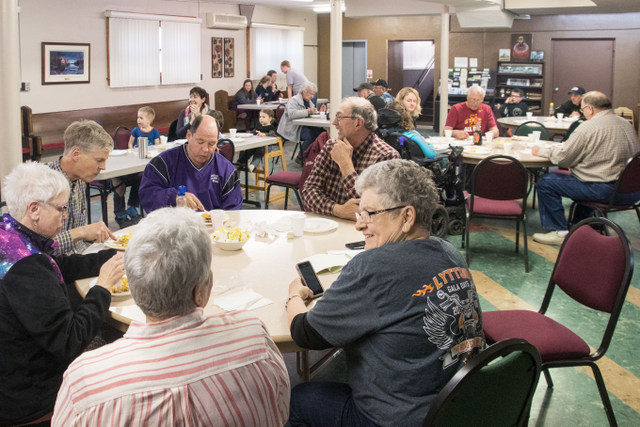
Doing Good, Eating Good at Lytton Town Night
What’s the glue that keeps a community connected? Around Lytton, Iowa, it’s food and fun at Lytton Town Night–and the homemade pie, of course.
While Lytton, Iowa, celebrates Gala Days each year during Memorial Day weekend, planning and fundraising for this beloved 100+ year tradition starts months earlier. In fact, a key part of the process starts in that most iconic of all small-town gathering places—the church basement.

Emanuel-St John Lutheran Church in Lytton, Iowa, hosts Lytton Town Night meals throughout the winter.
The basement dining area at Emanuel-St John Lutheran Church, whose congregation has roots dating back to 1883, provides a convenient setting for Lytton Town Night, which is held each Thursday evening from mid-January through March. Each Town Night offers a unique opportunity for the community to come together for free-will-donation meal to raise money for various causes and organizations, including Gala Days.
“Town Night is great, because there are a lot of fabulous cooks around Lytton,” said Nelda Bartels, a lifelong Lytton-area resident who often volunteers at Town Night.
As word of Town Night has spread through the years, guests come not only from Lytton, but Lake City, Sac City, Rockwell City and beyond. It’s not uncommon to serve a few hundred people at each meal.
“It’s like one big family when everyone gets together,” said Wendy Miller with the Lytton Chamber of Commerce.
Lytton Town Night includes groups like the Gala Days volunteers, the South Central Calhoun FFA chapter, 4-H clubs, civic groups and individuals raising money for worthy causes, including overseas mission trips. The Lytton Chamber of Commerce coordinates the schedule for Town Night, which allows eight to 10 different groups and individuals to host a Town Night meal during the winter, complete with home-cooked food. Some groups serve a selection of pasta casseroles, while others like the local FFA members serve pancakes and sausage links.
“I like the food, because it’s all good,” said Randy Souder, a Lytton-area farmer. “It’s also affordable, so everyone can come.”
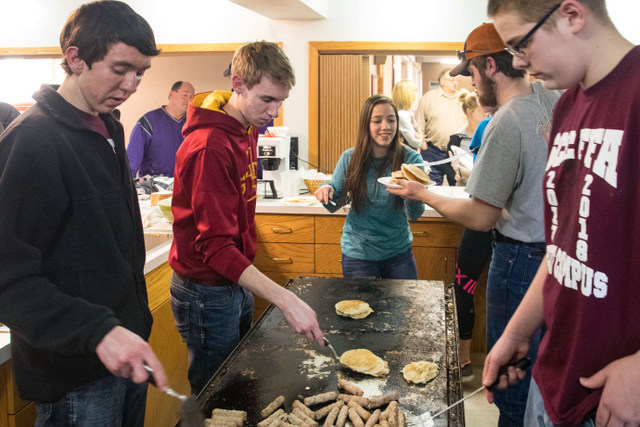
Members of the South Central Calhoun FFA chapter cooked pancakes and sausage during a Lytton Town Night fundraiser.
While no one is quite sure when Lytton Town Night started, it has been around since at least 1980, according to local-time residents. “It’s such a fun event, because you get to visit with friends and neighbors you don’t always see,” said Marlene Glasnapp, who lives with her husband, Roger, on a farm south of Lytton and is known as one of the best pie bakers in the area.
Each Town Night event is promoted through the Lytton Town Crier and on social media through Facebook. Each meal runs from 5 p.m. to 7 p.m. each Thursday evening during the winter. The popular gatherings attract people of all ages, from babies to grandparents.
Some groups, like the Gala Days volunteers, serve a lunch and a dinner meal when it’s their turn to host Town Night. “We usually have casseroles and homemade pie,” Bartels said. “The homemade pie is the kicker, because it’s always a hit.”
When the meal is done, the fellowship continues in downtown Lytton at the 1950s-era American Legion hall for bingo. “Town Night bingo has been called Lytton’s winter sport,” Bartels said.
The evening of bingo lasts about an hour and a half, and participants can play as many cards as they want. Two cards cost $3, and the proceeds support the American Legion.
Town Night isn’t just a fun evening, added Brian Lantz, an ag instructor at South Central Calhoun High School who advises the local FFA chapter. “It’s a local tradition, plus the kids learn how to work with the public when it’s their turn to cook and serve the meal.”
Keeping the Town Night tradition alive is important to residents of Lytton, which has a population of 302 residents. “Every year we wonder if we’ll be able have Town Night again,” Miller said. “We’re going to keep it going as a long as we can.”
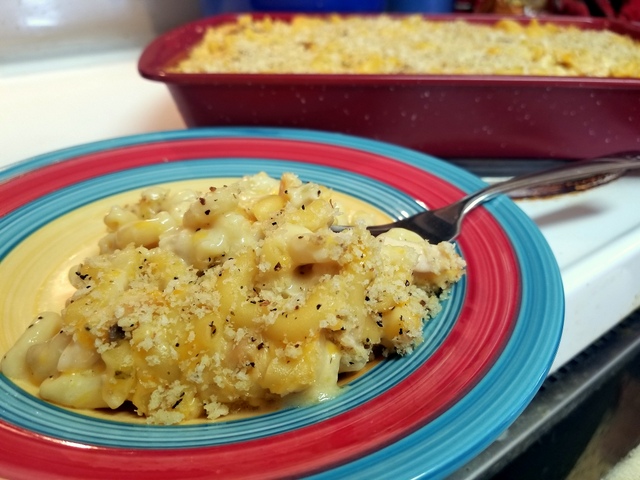
Creamy Chicken Pasta Casserole
Creamy Chicken Casserole
This simple, hearty dish from Nelda Bartels of Lytton was served at the Gala Days fundraiser at Lytton Town Night in March 2018.
3 boneless, skinless chicken breasts, cooked and shredded
1 teaspoon garlic powder
1 tablespoon olive oil
1 10.75-ounce can cream of chicken soup
1 10.75-ounce can cream of mushroom soup
1 cup milk
1 bag (2 cups) shredded Cheddar cheese
1 / 2 teaspoon ground black pepper
1-pound box elbow macaroni (cooked according to package directions)
1 1 / 2 cups panko bread crumbs or regular bread crumbs
Preheat oven to 350 degrees. Cook chicken with garlic powder. (Nelda uses a programmable pressure cooker and adds a couple cups of chicken broth.) Drizzle with olive oil. When done, shred chicken with a fork, and save the juice.
Combine the two cream soups, milk, cheese, cooked chicken, broth from chicken and pepper. (If desired, add some sour cream or cream cheese into the mixture for extra flavor and creaminess.) Add cooked macaroni. Stir the mixture and pour into a 9-inch by 13-inch casserole pan.
Top casserole with panko breadcrumbs. Bake at 350 degrees for 20 to 25 minutes. Brown panko topping under broiler on low for 3 to 5 minutes. Watch closely, since the breadcrumbs can burn quickly.
Bowtie Lasagna Casserole
This tasty recipe comes from Nelda Bartels of Lytton.
1 jar spaghetti sauce
1 to 1.5 pounds ground beef
1 package bowtie pasta noodles (cooked according to package directions)
1 small carton cottage cheese
1 8-ounce package cream cheese
1 small carton sour cream
Mozzarella cheese
Preheat oven to 350 degrees. Brown hamburger; mix with spaghetti sauce. Pour sauce on bottom of 9-inch by 13-inch baking pan. Combine hamburger and bowtie pasta. Combine cottage cheese, cream cheese, and sour cream. Add to hamburger/pasta mix; pour in baking pan. Top with mozzarella cheese.
Bake at 350 degrees for 45 minutes to 1 hour.
Poppy Seed Chicken
This recipe comes from Susan Albright of Lytton.
4 chicken breasts, cooked and cubed
1 carton (16 ounces) sour cream
1 10.75-ounce can cream of chicken soup
Very small handful of spaghetti, broken into pieces and cooked (Susan Albright uses three fourths of a box of angel hair pasta)
1 stick butter
40 Ritz crackers, crushed
1 / 2 tablespoon poppy seeds
Preheat oven to 350 degrees. After cooking chicken, season to taste with garlic salt and onion. Combine sour cream and soup. Add cubed chicken and cooked spaghetti to mixture. Add salt, to taste.
Pour mixture into greased, 9-inch by 13-inch baking dish.
In a separate bowl, melt butter; add crushed crackers and poppy seeds. Sprinkle cracker mixture on top of casserole. Bake for 20 minutes.
Pie Crust
For decades, Marlene Glasnapp of rural Lytton has relied on this recipe, which yields approximately 6 crusts per batch.
5 cups flour
1 teaspoon salt
1 pound lard
1 cup water
Combine flour and salt. Cut lard into the flour mixture. Add water, a little at a time, mixing quickly and evenly until dough just holds together in a ball. Divide dough for six crusts. (The crusts can be frozen for later use, and Marlene often rolls hers out before freezing.)
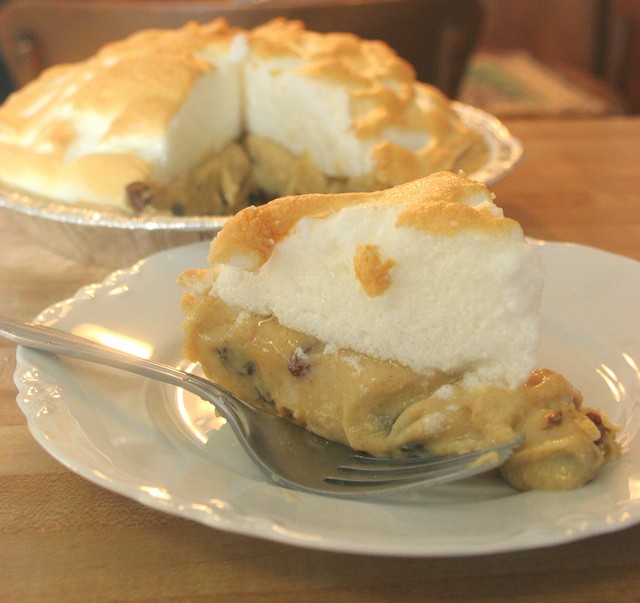
Raisin Cream Pie
Marlene Glasnapp’s raisin cream pie is always a hit wherever it’s served.
1 cup granulated sugar
3 tablespoons flour
1 / 2 teaspoon salt
1 teaspoon cinnamon
2 cups half-and-half
3-4 egg yolks (depends on the size of the eggs)
1 cup raisins
Mix dry ingredients with 1 / 2 cup of half-and-half, and set aside. Whisk egg yolks, and combine remaining half-and-half with the yolks. Add this mixture to the pie filling mix you set aside earlier.
Add raisins to the mixture and stir over medium heat until thick. Cool slightly. Pour in baked pie shell and top with meringue.
Meringue
1 tablespoon cornstarch
1 / 2 cup plus 1 tablespoon water
3 to 4 egg whites (depending on the size of the eggs)
3 to 4 tablespoons granulated sugar
Dissolve 1 tablespoon of cornstarch in 1 tablespoon of water. Boil 1 / 2 cup water and add to cornstarch mixture. Cook until clear. (This can be done in the microwave.) Beat egg whites and gradually add sugar. Add cooled cornstarch mixture and beat to proper consistency. Spread meringue over top of pie, sealing to the edge. Bake pie at 350 degrees Fahrenheit until meringue has browned.
Note from Darcy: I first wrote this piece in 2018 for Farm News.
Want more?
Thanks for stopping by. I invite you to read more of my blog posts if you value intriguing Iowa stories and history, along with Iowa food, agriculture updates, recipes and tips to make you a better communicator.
If you like what you see and want to be notified when I post new stories, be sure to click on the “subscribe to blog updates/newsletter” button at the top of this page, or click here. Feel free to share this with friends and colleagues who might be interested, too.
Also, if you or someone you know could use my writing services (I’m not only Iowa’s storyteller, but a professionally-trained journalist with 20 years of experience), let’s talk. I work with businesses and organizations within Iowa and across the country to unleash the power of great storytelling to define their brand and connect with their audience through clear, compelling blog posts, articles, news releases, feature stories, newsletter articles, social media, video scripts, and photography. Learn more at www.darcymaulsby.com, or e-mail me at yettergirl@yahoo.com.
If you’re hungry for more stories of Iowa history, check out my top-selling “Culinary History of Iowa: Sweet Corn, Pork Tenderloins, Maid-Rites and More” book from The History Press. Also take a look at my latest book, “Dallas County,” and my Calhoun County” book from Arcadia Publishing. Both are filled with vintage photos and compelling stories that showcase he history of small-town and rural Iowa. Order your signed copies today! Iowa postcards are available in my online store, too.
Let’s stay in touch. I’m at darcy@darcymaulsby.com, and yettergirl@yahoo.com.
Talk to you soon!
Darcy
@Copyright 2018 Darcy Maulsby & Co. Blog posts may only be reprinted with permission from Darcy Maulsby.
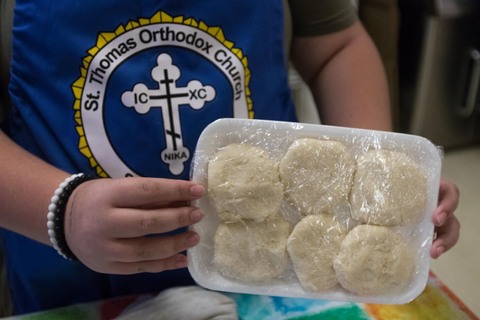
Mediterranean Delights: Iowa Ag Influences Syrian-Lebanese Church Dinner
Call it controlled chaos. Anyone who has ever helped with a church fundraising dinner knows just how hectic, harried and fun it can be to work together to prepare the meals. That’s especially true at St. Thomas Orthodox Church in Sioux City.
“It’s a lot of work and requires all hands on deck,” said Erica Stickney, a chairperson who helps coordinate St. Thomas’s popular Syrian-Lebanese dinner, which was held on Sept. 10 this year.
“While it can get a little frustrating at times when things get really busy and the kitchen’s hot, you remember that it’s about friendship and love, including love for God and the community.”

St. Thomas Orthodox Church has served the Sioux City community since 1916.
Homemade dinners at this year’s Syrian-Lebanese dinner, which was served from 12:30 p.m. to 6 p.m., cost $13 each, with a portion of the proceeds going to The Warming Shelter, a non-profit charity in Sioux City. While this year’s menu served plenty of Mediterranean favorites, many had a Midwestern twist. “Traditionally the meat would have been lamb, but we use beef, because we’re in Iowa,” Stickney said.
The menu included:
• Kibby (or kibbeh). This tasty meatloaf is made with lean ground beef and cracked bulgur wheat, seasoned with cinnamon and allspice.
• Yabrah. Much like cabbage rolls, yabrah includes cabbage leaves that are rolled and stuffed with a spiced blend of beef, rice and tomatoes. “We rolled 5,515 of these this year,” said Sue Stevens of Sioux City. “It’s rewarding to hear our guests say the cabbage rolls are perfect.”
• Lubee. This simple, yet satisfying side dish, features green beans in a tomato and meat sauce.
• Ruz. This Syrian favorite includes buttery white rice accented with tiny orzo pastas.
• Salata. This Syrian salad is enhanced with the church’s special dressing made of oil, vinegar, lemon juice and seasonings.
• Talamee. These big, round loaves of Syrian bread are indescribably tasty, report church members.
• Baklawa. Sometimes called baklava, this classic Mediterranean dessert is made with phyllo pastry dough, butter, and walnuts in a sweet syrup.
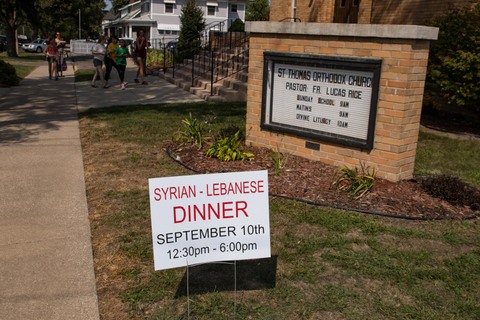
A steady stream of people stopped by St. Thomas Orthodox Church in Sioux City in September 2017 for the popular Syrian-Lebanese dinner.
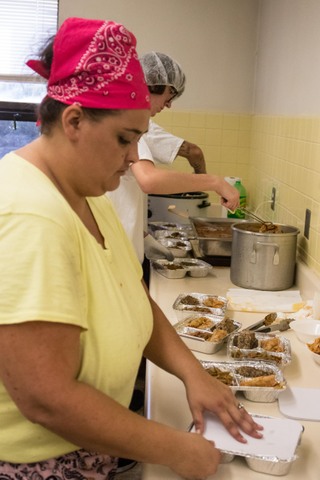
Erica Stickney, a chairperson who helps coordinate St. Thomas’s popular Syrian-Lebanese dinner in Sioux City, dished up countless carryout dinners.
Diverse influences create beloved traditions
While St. Thomas is located in the heart of Sioux City, the parish’s heritage, much like its dinner specialties, reflects a mix of Mediterranean and Midwestern influences. The church was founded in 1916 to serve the needs of Arab Christian immigrants, many of whom came to the area to work in the Sioux City Stockyards or local meatpacking plants. Today’s members embody a diverse background of Mediterranean, Russian, Serbian and Romanian heritage.
“Historically, Sioux City has been very welcoming and accepting of newcomers,” said Father Lucas Rice, who has served the St. Thomas parish more than six years. “When I came here, I was also blown away by how much the people of Siouxland love the St. Thomas church dinner.”
While no one’s sure exactly how long St. Thomas’s congregation has been hosting the dinner (anywhere from 50 years to nearly 80 years, depending on who you ask), there’s no doubt that people mourned the loss of the dinner when the church discontinued it for a few years.
“We hadn’t hosted the dinner in three years, because our church demographics were changing and the older generation was stepping down,” said Stickney, who noted that previous generations cooked without recipes and made their own phyllo dough. “The younger generation had to decide the next steps, and we decided to carry on the tradition.”
Before the older generation retired, younger cooks in the church worked side by side with the experienced cooks so they could observe each step of the process. “We would stop them as they added ingredients so we could determine the measurements and write the recipes,” Stevens said. “While we follow the recipes, we taste the food as we prepare it to make sure it’s right.”
Church members prepared to serve 1,400 dinners on Sept. 10. The process started three weeks before the dinner. “We begin by clarifying the butter,” said Stickney, who noted that 236 pounds of butter are used to prepare the cookies, rice and more. “Clarified butter has the milk solids removed and influences the taste and look of the food.”
The bread is baked on the Saturday right before the dinner, and the rest of the dishes are prepared fresh the day of the church dinner. “I love to come back for this dinner,” said Rick Stevens of Lincoln, Nebraska, whose family has been part of the St. Thomas parish for generations. “This is home.”
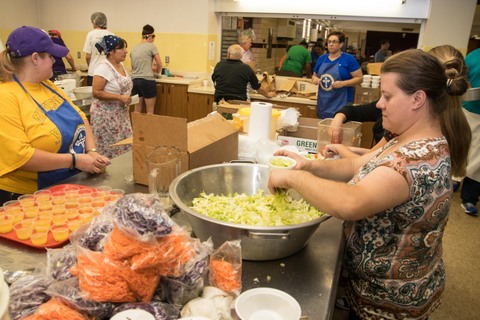
It’s all hands on deck in the basement kitchen at the St. Thomas Orthodox Church Syrian-Lebanese dinner and bake sale in Sioux City.
Clarified Butter
Slowly melt butter in pan on low heat. Be careful not to boil. When butter is completely melted, carefully skim all of the milk fat from the top and discard fat. The result is pure gold butter. This is used in most Arab recipes.
Ghraybeh (Lebanese Butter Cookies)
1 cup clarified butter
1 cup powdered sugar
2 cups flour
With hand mixer, whip butter until creamy pale and fluffy. Add sugar, and mix until fluffy. Using a large rubber spatula, blend in flour a little at a time.
Roll dough into balls and place on cookie sheet. Press to flatten. Work quickly so dough doesn’t get too soft. Bake in preheated oven (300 degrees) until cookies are firm, 10 to 12 minutes. Don’t let cookies get brown. Remove cookies from pan and let cool.
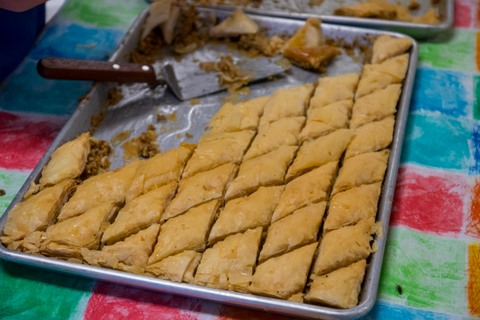
Homemade baklawa (baklava) is always in demand at the St. Thomas Orthodox Church Syrian-Lebanese dinner and bake sale.
Baklawa (also known as Baklava)
4 cups finely chopped walnuts
2 cups clarified butter-melted
1/8 cup granulated sugar
2 packages phyllo dough (20 sheets per package)
Combine walnuts with sugar and 1/4 cup butter so mixture forms a ball when squeezed in your hand.
Grease a large baking sheet with butter. Place one package of phyllo carefully on to baking sheet. Spread walnut mixture on top evenly. Carefully place second package of phyllo
on top of walnut mixture. Carefully take off top five layers of phyllo.
Butter the top layer of phyllo dough on the pan, and then place a single layer of phyllo on top of buttered layer. Repeat until all lawyers are back on to pan. Put butter on top layer. Cut into diamond shapes.
Bake in preheated, 375-degree oven for 25 minutes. Remove from oven. Pour a little butter on the top evenly. Place pan back into the oven for another 20 minutes or so, until the baklawa is golden brown.
Remove pan from oven and place on cooling rack. Immediately pour syrup mix (see recipe below) evenly on top of entire pan. Let pan sit for one day. Allow syrup to soak through the entire dessert. You may want to re-cut baklawa before removing from pan.
Syrup for Baklawa
2 1/2 cups granulated sugar
1 1/2 cups water
1 tablespoon lemon juice
In a pan, heat water and sugar until boiling. Once mixture starts to boil, add the lemon juice. Cook for another 15 minutes until the syrup starts to thicken. Remove pan from heat, and set aside to cool.
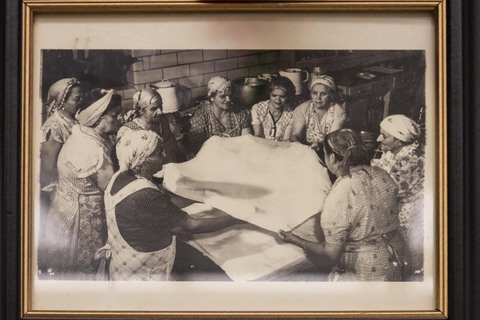
Previous generations of church members made their own phyllo dough at St. Thomas Orthodox Church in Sioux City, Iowa.
Barazek (Sesame Cookies)
1 cup butter
1/2 cup sugar
1 egg
1/2 teaspoon vanilla
3 cups flour
1/4 teaspoon salt
1 teaspoon baking powder
1/2 cup milk
3 tablespoons pistachios chopped
1 egg white
3 tablespoons sesame seeds
Preheat oven to 350 degrees. Cream butter and sugar with electric mixer until light and fluffy. Add egg and vanilla, continue beating. In separate bowl, mix flour, salt and baking powder. Stir flour mixture gradually into butter mix, alternating with milk.
Knead dough on lightly floured surface. Divide dough into two parts. Roll each piece into a circle, and cut into rounds. Place pistachios on a cookie sheet; spread evenly. Place dough rounds on top of pistachios, and press lightly. Beat the egg bite and then brush the tops of cookies. Sprinkle with sesame seeds. Bake about 15 minutes, or until golden brown.
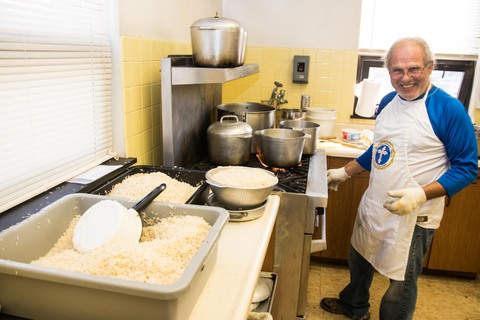
Ruz (a Syrian favorite of buttery white rice accented with tiny orzo pastas) is cooked in large quantities at the St. Thomas Orthodox Church Syrian-Lebanese dinner.
Want more?
Thanks for stopping by. I invite you to read more of my blog posts if you want more more intriguing Iowa stories and history, along with Iowa food, recipes and tips to make you a better communicator.
If you like what you see and want to be notified when I post new stories, be sure to click on the “subscribe to blog updates/newsletter” button at the top of this page. Feel free to share this information with friends and colleagues who might be interested, too.
If you’re hungry for more stories of Iowa history, check out my top-selling “Culinary History of Iowa: Sweet Corn, Pork Tenderloins, Maid-Rites and More” book from The History Press. Also take a look at my latest book, “Dallas County,” and my Calhoun County” book from Arcadia Publishing. Both are filled with vintage photos and compelling stories that showcase he history of small-town and rural Iowa. Order your signed copies today! Iowa postcards are available in my online store, too.
Let’s stay in touch. I’m at darcy@darcymaulsby.com, and yettergirl@yahoo.com.
P.S. Thanks for joining me. I’m glad you’re here.
@Copyright 2017 Darcy Maulsby & Co.
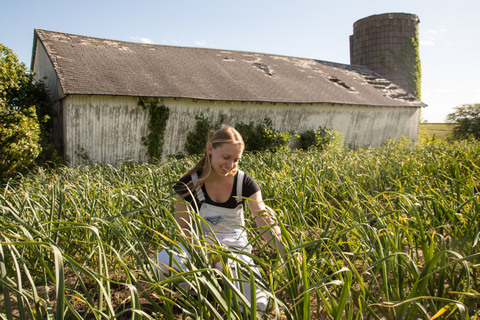
Ultra-Local Eating: Jennifer Miller Guides CSA, Iowa Food Cooperative
Jennifer Miller could hardly believe the question. “When will your bananas be ready?” inquired a central Iowa woman who was buying fresh produce through Miller’s Clarion Sage market garden and community supported agriculture (CSA) business near Waukee.
“People are disconnected from where their food comes from,” said Miller, 30, who noted the woman seeking locally-grown bananas is a well-educated business professional. “I’ve even had people look at our heirloom tomatoes and say, ‘I don’t want those,’ because they think they are GMOs.’”
This disconnect isn’t all that foreign to Miller, who grew up in Highland Park, Illinois, a northern suburb of Chicago. “I had no contact with agriculture in Highland Park,” said Miller, who serves as the Iowa Food Cooperative’s member services coordinator.
Miller did have a connection with Iowa, though, through her paternal grandparents, who lived in the Clarion/Rowan area. Her decision to move to Iowa in 2010 was spurred, in part, by a health challenge and new-found passion for healthy eating.
Miller was diagnosed a number of years ago with celiac disease, a serious autoimmune disorder where consuming gluten can damage the small intestine. “I started caring more about cooking and healthy recipes, because I just wanted to feel better,” said Miller, whose gluten-free and vegan recipes on her blog caught the attention of Martha Stewart Living editors, who invited her to develop recipes for them. “That’s what got me into food and agriculture.”
Food can be so much more interesting
After moving to Iowa, Miller got involved with community gardens in the Des Moines area and became a marketing/communications specialist Iowa Food Cooperative, which operates like an online farmers market. In 2013, Miller and her partner, Cody Kilgore, moved to an acreage on the southwest edge of Waukee’s city limits in Van Meter Township so they could operate their own farm.
“It felt like coming full circle,” said Kilgore, who was raised in rural Missouri, worked in the corporate world for nearly 30 years and was ready for a career switch.
 The couple planted garlic in the fall of 2013 to start their Clarion Sage market garden. The goal? “We believe in ultra-local and want to feed the community around us,” said Miller, who noted that Clarion Sage primarily serves families within a five-mile radius in southern Dallas County.
The couple planted garlic in the fall of 2013 to start their Clarion Sage market garden. The goal? “We believe in ultra-local and want to feed the community around us,” said Miller, who noted that Clarion Sage primarily serves families within a five-mile radius in southern Dallas County.
Today, Miller and Kilgore raise a wide array of vegetables and herbs, including lettuce, squash, cabbage, carrots, garlic, tomatoes, cucumbers, peppers, potatoes and more, including heirloom varieties that can’t be found in most stores. They offer an online ordering system for added convenience.
“Food can be so much more interesting,” Miller said. “Whether you’re sharing a family meal, providing snacks for your kids or making a favorite recipe, one thing’s for sure: the starting point for all these is good food.”
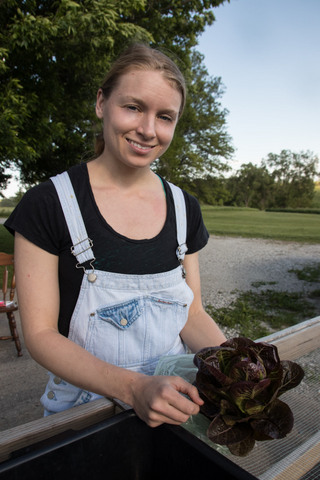
Jennifer Miller displays one of the unique lettuce varieties she grows at Clarion Sage Farm near Waukee.
Six lessons learned about farming and food
As their business evolved, Miller and Kilgore have adjusted their marketing plan to adapt to the often surprising—and sometimes frustrating—buying patterns they’ve observed in the market. The Clarion Sage market garden and CSA have taught them six key lessons, including:
1. Farming is more than production. Raising an abundant crop is just step one, said Miller, who has learned that that marketing and sales are equally important.
2. Mentors matter. “I didn’t grow up gardening, so working for various produce growers in Iowa and beyond taught me so much,” said Miller, who is grateful for leaders like Angela Tedesco who started Turtle Farm near Granger, Jill Beebout from Blue Gate Farm near Chariton and other local food proponents who have mentored her along the way.
3. Buying local adds flavor to life. Clarion Sage’s customers appreciate the “know your farmer” philosophy. Most buyers tend to be in their 30s and 40s with families, or they’re retired and have an interest in good food and time to cook. “Every week we offer our customers about $30 worth of fresh vegetables,” Miller said. “We focus on staple items like lettuce, potatoes, carrots and tomatoes, with the opportunity for more exotic options like stir-fry greens, kale and eggplant.”
4. Catering to consumers can be tricky. While the Clarion Sage CSA is right on Waukee’s doorstep, some consumers don’t want to drive to the farm to pick up vegetables. Some feel they don’t have time, while others don’t like the way the gravel road makes their vehicle dusty. When Miller tried offering delivery, some consumers still rejected this option, citing a lack of time or interest in preparing fresh food. Even full-color newsletters filled with cooking tips and recipes failed to gain much traction with these types of consumers, said Miller, who plans to start selling her produce at the Downtown Farmers’ Market in Des Moines.
5. Urban sprawl is relentless. High-density residential projects are planned for the area near the Clarion Sage’s market garden. “We’re in the bullseye of urban sprawl, which is a challenge,” said Kilgore, who also works as a wedding photographer.
6. Local food pairs well with global flavors. Miller loves ethnic cooking, from Latin American to African. “If you want to add more vegetables to your diet, look to other cultures that don’t have an abundance of meat protein,” said Miller, who encourages people to try vegetables like Cherokee Purple heirloom tomatoes (known for their smoky, complex flavor), fish peppers (which pack more heat), Merlot lettuce (whose dark red leaves offer a mellow flavor) and fingerling potatoes (which taste great fried or roasted).
Food is one of the best parts of life, added Miller, who loves the creativity involved in growing and marketing a crop. “You see a crop through from beginning to end, and you’re producing something that can feed and sustain people. That’s amazing to me.”
Want more?
Thanks for stopping by. I invite you to read more of my blog posts if you want more more intriguing Iowa stories and history, along with Iowa food, recipes and tips to make you a better communicator. If you like what you see and want to be notified when I post new stories, be sure to click on the “subscribe to blog updates/newsletter” button at the top of this page. Feel free to share this information with friends and colleagues who might be interested, too.
If you’re hungry for more stories of Iowa history, check out my top-selling “Culinary History of Iowa: Sweet Corn, Pork Tenderloins, Maid-Rites and More” book from The History Press, as well as my Calhoun County” book from Arcadia Publishing, which showcases the history of small-town and rural Iowa. Order your signed copies today! Iowa postcards are available in my online store, too.
Let’s stay in touch. I’m at darcy@darcymaulsby.com, and yettergirl@yahoo.com.
P.S. Thanks for joining me. I’m glad you’re here.
@Copyright 2017 Darcy Maulsby & Co.
About me:
Some people know me as Darcy Dougherty Maulsby, while others call me Yettergirl. I grew up on a Century Farm between Lake City and Yetter and am proud to call Calhoun County, Iowa, home. I’m an author, writer, marketer, business owner and entrepreneur who specializes in agriculture. Learn more at www.darcymaulsby.com.
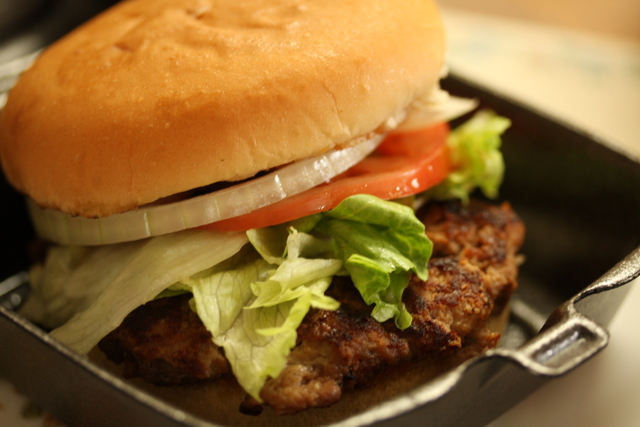
Get Your Grill On: How to Build a Better Burger
Love the thrill of the grill? I sure do, especially when I’m crafting a thick, juicy burger I can sink my teeth into. While we talk a lot about burgers during May Beef Month, how much do you really know about this American icon?
The classic hamburger we know and love today is very much an American invention. Stemming from German culinary roots, the burger-on-a-bun phenomenon gained widespread fame at the 1904 St. Louis World’s Fair.
Disaster struck two years later, however, when Upton Sinclair’s novel “The Jungle” (remember the book’s lurid details from high school literature class?) detailed the unsavory side of the American meatpacking industry. Ground beef became a prime suspect, since it could easily be adulterated with questionable additives.
The hamburger might have faded away as a long-forgotten fad were it not for Edgar Ingram and Walter Anderson. When they opened their first White Castle restaurant in Kansas in 1921, White Castle countered the hamburger’s unsavory reputation by becoming bastions of cleanliness, health and hygiene. This paved the way for national hamburger chains founded in the post-World War II boom years, including McDonald’s.
Best burgers, Iowa style
Iowa has made its own distinctive contributions to America’s burger history. Consider the wildly popular Iowa’s Best Burger contest, sponsored by the Iowa Cattlemen’s Association (ICA) and the Iowa Beef Industry Council (IBIC). Iowans submitted more than 9,200 nominations for this year’s contest. Nearly 500 Iowa restaurants were represented in 2017 in the total nominations, setting a new record for the contest.
As a former judge of Iowa’s Best Burger contest, I can tell you how tough it is to pick a winner. Iowans know how to make bodacious burgers, a story I made sure to include in my “Culinary History of Iowa” book.
Size matters when it comes to the Gunderburger at the Irish Shanti, which made the 2017 Top 10 list. The famous Gunderburger started in the late 1970s to put the tiny northeast Iowa community of Gunder on the map. The first Gunderburgers were a smaller version of the one served today. As the Gunderburger started growing in size in the 1990s, its notoriety also grew.
Another 2017 Top 10 Best Burger in Iowa contender is the Ankeny Diner, which offers Maytag Burgers, featuring Iowa’s famous Maytag blue cheese, sautéed onion and Monterey jack cheese. Don’t care for blue cheese? Maybe you’d prefer the Rarebit Burger, served open-faced and topped with spicy Cheddar cheese sauce.
Rarebits were legendary at the iconic Younkers Tea Room in downtown Des Moines for decades. An Iowa-style rarebit burger elevates the traditional Welsh rarebit, which incorporates leftover bits of cheese and the end-of-the-loaf slices of stale bread for a quick supper.
Speaking of Des Moines, the historic East Village is the home of the incomparable Zombie Burger. A previous Top 10 Best Burger in Iowa contender, Zombie Burger serves “gore-met” creations made from the shop’s own custom three-cut beef burger blend. With locations in downtown Des Moines, Ankeny, West Des Moines and the Iowa City area, Zombie Burger is distinguished by classics from the Undead Elvis (a burger paired with peanut butter, fried bananas, bacon, American cheese and mayo) to the Walking Ched (a burger featuring bacon, Cheddar cheese, caramelized onions and mayo on a deep-fried macaroni-and-cheese bun).
Hungry yet?
If all this inspiration has you craving top-quality, Iowa beef, here are my top tips to make your best burgers ever:
• Choose fresh 80/20 ground beef, which provides enough fat to keep your burgers juicy and flavorful.
• Worcestershire sauce adds a whole new depth of flavor to burgers. Add in a healthy dollop and mix it into the meat before forming the patties.
• Use your thumb to create a dimple or well in the center of each patty on the bottom. This helps ensure that the burgers cook evenly. Don’t worry—the indentation will hardly be noticeable by the time the burgers are ready.
• Cook your burgers over medium heat.
• As the patties cook, sprinkle them liberally on both sides with a mixture of salt, fresh-ground pepper, Lawry’s seasoning salt, garlic powder and onion powder.
• Avoid using your spatula to press down on your burgers while cooking. Don’t let all those flavorful juices escape.
• Allow your burgers to rest for a few minutes before serving. This will ensure that the juices redistribute into the meat. Enjoy!
Have any favorite burger recipes or cooking tips? I’d love to hear them. Now go get your grill on!
Hungry for more?
Want more burger inspiration? Check out my blog post on the Lake City Drive-In, where owner Larry Irwin is not only a beef booster, but someone who sees burgers as the perfect palette for culinary creativity with his Burger of the Month flavors. (Don’t miss my recipe for Meatloaf Burgers!)
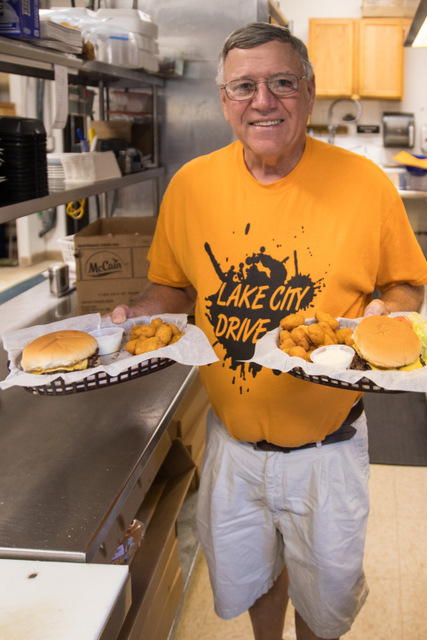
Larry Irwin shows off some tasty burgers from the Lake City Drive-In.
If you’re hungry for more stories of Iowa history, Larry is kind enough to carry my books at the Lake City Drive-In. Not close to Lake City? I invite you to visit my online store, where you can purchase my top-selling “Culinary History of Iowa: Sweet Corn, Pork Tenderloins, Maid-Rites and More” book from The History Press, as well as my “Calhoun County” book from Arcadia Publishing, which showcases the history of small-town and rural Iowa. Order your signed copies today! Iowa postcards are available in my online store, too.
One more thing–check out more of my blog posts if you want more Iowa stories, history and recipes, as well as tips to make you a better communicator. If you like what you see and want to be notified when I post new stories, be sure to click on the “subscribe to blog updates/newsletter” button at the top of this page. Let’s stay in touch!
This originally appeared as one of my weekly columns in Farm News.
P.S. Thanks for joining me. I’m glad you’re here.
@Copyright 2017 Darcy Maulsby & Co.
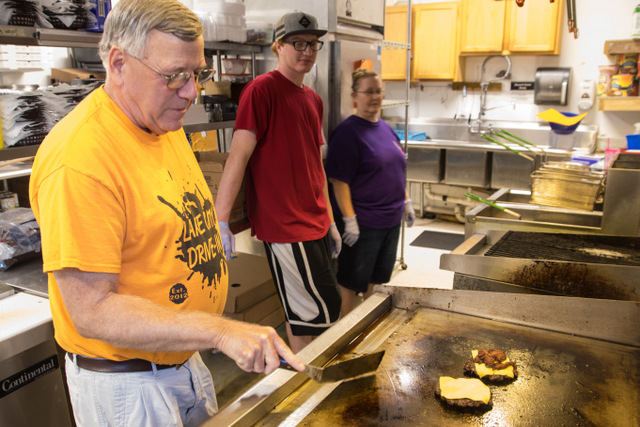
Iowa Beef Booster: Larry Irwin Takes a New Twist on Burgers
Make no mistake, the humble hamburger still reigns supreme from backyard barbecues to fast-food drive-ins across Iowa. But this Iowa icon also provides the perfect palette for culinary creativity when my friend Larry Irwin showcases his Burger of the Month flavors in my hometown of Lake City.
“I’m not doing anything fancy,” said Irwin, who has run the Lake City Drive-In since 2012. “I just like cooking down-home, comfort food.”
While it’s hard to beat a classic bacon cheeseburger, which remains one of the Lake City Drive-In’s top sellers, customers also love the monthly burger specials. Favorites include the Taco Burger (spiced with taco seasoning and chipotle and topped with nacho-cheese flavored chips), Darcy’s Meatloaf Burger, the Swiss Mushroom Burger, and the Ranch Burger (enhanced with homemade ranch dressing, pepper jack cheese and bacon).
“Burgers of all types are always our top sellers,” said Irwin, who serves more than 50 burgers a day, on average. “It’s fun to experiment with new flavors and feature them as the Burger of the Month.”
Top tips for unbeatable burgers
Interestingly, this adventurous spirit in the kitchen isn’t second nature for Irwin, who spent more than 30 years of his career in finance and banking. “I never did much cooking at home,” said Irwin, who grew up on a cattle and grain farm between Lohrville and Rockwell City. “I certainly never thought I’d run a restaurant.”
Irwin has found that offering new men

Larry Irwin shows off some tasty burgers from the Lake City Drive-In.
u items is one of the secrets to keep people coming back to the Lake City Drive-In. Inspiration for the Burger of the Month comes from a variety of sources.
“Sometimes our customers suggest ideas,” Irwin said. “A lot of the Burger of the Month ideas come from my son, Chris, who is an agronomist in northeast Iowa. He travels a lot for his job and tells me about burger flavors he discovers in various cafes.”
While unique flavors are part of the fun, a great burger starts with the basics, said Irwin, who shares the following tips:
• Select an 80/20 ground beef for the best flavor. Irwin always uses fresh beef, never frozen patties, to make his 1/3 pound burgers.
• Preheat the grill before you place the hamburger patties on the grill.
• Cook the hamburger patties over medium heat. If the temperature is too high, it’s easy to burn the outside of the burger and leave the inside undercooked, said Irwin, who cooks his burgers for about five minutes on each side.
• Season the patties on the grill. Irwin sprinkles a mix of garlic powder, onion powder, Lawry’s seasoning salt, table salt, white sugar and black pepper on both sides of each hamburger patty as the meat cooks.
• Don’t forget to butter and toast the bun before serving the burger.
Time-saving systems in the kitchen are also invaluable. Since the Lake City Drive-In is located on Main Street across from South Central Calhoun High School, things can get hectic when hungry crowds stop by, especially during volleyball tournaments and home football games. Irwin plans ahead on these days and cooks each hamburger patty for two minutes per side before placing the partially-cooked patties in a warm slow cooker. When the crowds arrive, it only takes a couple more minutes of grilling time before the burgers are ready.
This strategy also pays off during planting and harvest, when the drive through becomes one of the busiest places at the Lake City Drive-In. “You can always tell when an order is going out to farmers, because there are at least five or six cheeseburgers in there,” said Irwin, who farmed at one point in his career.
Keeping things simple while adding a little variety is the key to a great burger, Irwin added. “I love the flavor of beef. If I could only have one meat for the rest of my life, I’d choose hamburger, because I can make anything out of it.”
Hungry for more? Check out my blog post and Farm News column “Get Your Grill On: How to Build a Better Burger.”

Darcy’s Meatloaf Burger
Darcy’s Meatloaf Burgers
Larry Irwin will be featuring these Meatloaf Burgers, made from my recipe, as the Burger of the Month in June 2017.
2 pounds ground beef
1 1 / 2 to 2 cups herb-seasoned stuffing mix (experiment to find what amount helps the burger patties stick together the best)
1 onion, chopped
1 teaspoon seasoning salt
1/4 teaspoon freshly-ground pepper
1 teaspoon garlic powder
2 large eggs, lightly beaten
1 /4 cup milk
2 tablespoons barbecue sauce
1 / 4 cup ketchup
2 tablespoons brown sugar
1 teaspoon dry mustard
Combine ground beef, stuffing mix, onion, salt, pepper and garlic powder. In a separate bowl, beat eggs, milk, and barbecue sauce. Combine barbecue sauce mixture with meat mixture.
In a separate bowl, combine ketchup, brown sugar and dry mustard. This mixture can either be spread as a glaze while the burgers are cooking on the grill, or the glaze can be mixed into the burger patty mixture before the burgers are grilled.
Shape beef mixture into patties. Grill over medium heat to desired doneness. If using the ketchup mixture as a glaze, spread over the top of each burger during the final minutes of cooking on the grill.
Ranch Dressing
While this makes restaurant-sized quantities, scale down the recipe for home use.
1 gallon regular mayonnaise
1 / 2 gallon buttermilk
2 packages (3.2 ounces each) powdered ranch dressing mix
Combine all ingredients and stir with an electric mixer. Refrigerate.
Boom Boom Sauce
This spicy sauce has a kick and tastes great on burgers and salads.
4 cups Thousand Island dressing
3 / 4 cup buffalo hot sauce
1 / 4 cup red pepper flakes
Combine dressing, buffalo sauce and red pepper flakes; refrigerate.
Sloppy Joes
1 pound hamburger
1 can chicken gumbo soup
Ketchup and mustard, to taste
Brown sugar, to taste
Salt and pepper, to taste
Brown the hamburger; drain. Add soup and season with ketchup, mustard, brown sugar, salt and pepper until the desired flavor is achieved.
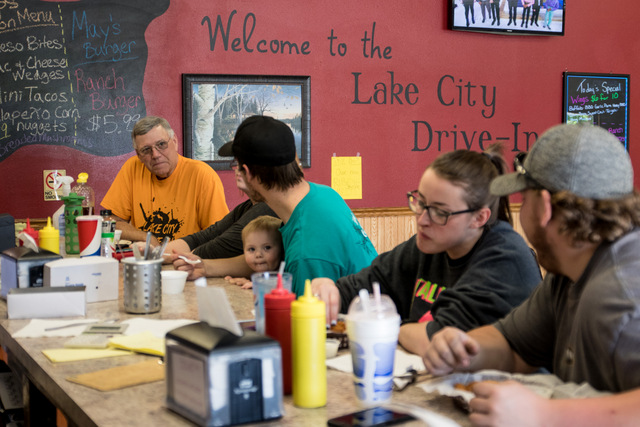
This story first ran on Farm News, May 2017.
Want more Iowa culture and history?
Read more of my blog posts if you want more Iowa stories, history and recipes, as well as tips to make you a better communicator.
If you’re hungry for more stories of Iowa history, Larry is kind enough to carry my books at the Lake City Drive-In. You can also check out my top-selling “Culinary History of Iowa: Sweet Corn, Pork Tenderloins, Maid-Rites and More” book from The History Press, as well as my Calhoun County” book from Arcadia Publishing, which showcases the history of small-town and rural Iowa. Order your signed copies today! Iowa postcards are available in my online store, too.
P.S. Thanks for joining me. I’m glad you’re here.
@Copyright 2017 Darcy Maulsby & Co.
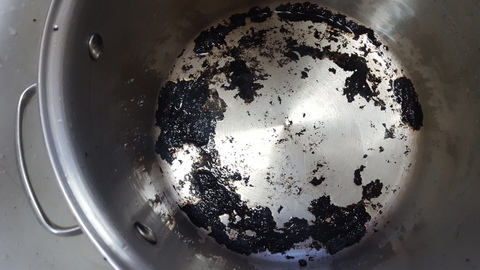
How to Clean a Burned Pan in 6 Simple Steps
Hey, it happens. If you cook, you’re going to have burned-on food once in awhile. Fear not! While dish soap is no match for this kitchen foe, arm yourself with baking soda and white vinegar to concoct an inexpensive, all-natural, non-toxic way to clean up the mess with as little hassle as possible.
I’m speaking from experience here. When the crew from the “State Plate” TV show hosted by Taylor Hicks came to my family’s Iowa farm recently, I was in the field filming with them as my pot of homemade Italian-Bean Soup simmered on the kitchen stove. The trouble started when I didn’t get back to the kitchen in time to turn down the heat. While the soup was still tasty, a scorched portion had formed on the bottom of the stainless steel soup kettle. Ugh.
If you end up in a predicament like this, first try the simplest trick–sprinkle some powdered dishwasher detergent in the messy pan, add some hot water, and scrub. You may have to repeat this a few times, but it usually works like a charm.
If you want to try a different method, you’ll need:
- Vinegar
- Baking soda
- Water
- Sturdy plastic spatula
- Scouring pad
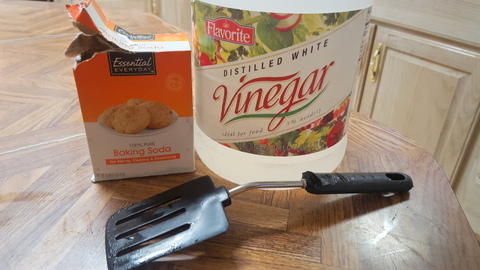 Here’s how to take control of that scorched pan in 6 simple steps:
Here’s how to take control of that scorched pan in 6 simple steps:
1. Fill the bottom of the pan with a layer of water to cover the scorched food.
2. Add 1 cup vinegar.
3. Bring the pan to the boil. (Some of the debris will probably start breaking loose–yeah!)
4. Remove the pan from the heat and add two generous shakes of baking soda. Watch it fizz and work its magic!
5. Empty the pan and scrub with a scouring pad. The plastic spatula can also come in handy to help loosen the scorched food. If necessary, add an extra bit of dry baking soda and keep scrubbing.
6. If there any stubborn marks don’t come off, make a paste of baking soda and a couple of drops of water. Leave the paste on the marks for a while and scrub again.
Depending on how tough the scorched food is, you may need to repeat this entire process a second time. You will get good results, though–I promise.
*If you have really tough scorch, pull out a box of powdered dishwasher detergent. Pour a dollop in your pan, cover the scorched area with water, bring to a boil, and watch the detergent work its magic. You still may need to scrub, but this gets results fast!
Congratulations, and good job! Now you’re ready to cook again.

Want more food for thought?
Check out my blog posts if you want more handy kitchen tips, recipes, culinary history, and Iowa food stories, along with simple tips to make you a better communicator.
If you’re hungry for even more, check out my top-selling “Culinary History of Iowa: Sweet Corn, Pork Tenderloins, Maid-Rites and More” book from The History Press, as well as my Calhoun County” book from Arcadia Publishing, which showcases the history of small-town and rural Iowa. Order your signed copies today! Iowa postcards are available in my online store, too. Coming soon in September 2017–my third Iowa history book! Watch for more details on “Dallas County” from Arcadia Publishing.
P.S. Thanks for joining me. I’m glad you’re here.
@Copyright 2017 Darcy Maulsby & Co.
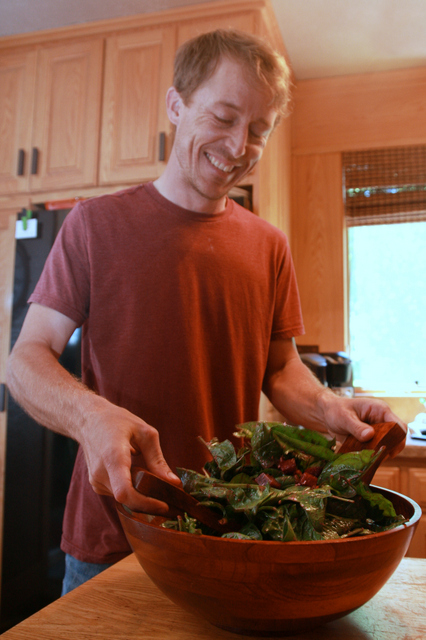
Very Veggie: Iowan’s Farm-Fresh Recipes Offer Guilt-Free Eating
For a guy who didn’t care for vegetables as a kid, Adam Nockels has come a long ways. Now he runs Iowa’s Raccoon Ridge Farm, which specializes in an array of naturally-grown produce.
“My foodie friends in college, including one who is a gardener, got me interested in fresh foods and new flavors,” said Nockels, who was born in Lake City but grew up on military bases before returning to the Lake City area.
Food production also appealed to Nockels, a U.S. Air Force veteran who used the G.I. Bill to attend Iowa State University, where he earned his biology degree in 2010. After completing an internship at Turtle Farm near Granger, where he learned about vegetable production and community supported agriculture (CSA), Nockels knew he wanted to work in production agriculture. When he proposed the idea of starting a farm on the land his family owns between Lake City and Auburn, his grandparents Dennis and Sheila Moulds liked the idea.
“My Grandma Sheila and my mom, Debby, have green thumbs,” said Nockels, who has 10 acres in Raccoon Ridge Farm, which includes 2.5 to 3 acres of vegetables grown with organic practices. “I also like working outdoors and growing healthy food for people.”
Nockels grows a wide variety of crops, including green beans, spinach, lettuce, radishes, strawberries, kale, herbs, squash, peas, potatoes, beets, heirloom tomatoes and more, which he sells at the Lake City Farmers Market and through his weekly CSA deliveries in Lake City, Rockwell City and Carroll. Nockels’ favorite heirloom tomato is the Cherokee Purple Tomato, a flavorful variety that was reportedly gifted to a farmer in Tennessee in the 1890s from Cherokee natives. “Nothing is better than an heirloom tomato,” Nockels said. “For me, it’s either slice, salt and go, or use the tomato in a BLT sandwich.”
Nockels’ weekly newsletters for CSA customers include a list of produce supplied that week, brief descriptions of the unique items in the box, tips for storing the produce, recipes and seasonal cooking tips such as how to roast chile peppers. Some of Nockels most popular items are his green beans. In 2015, the sandy, loamy soils of Raccoon Ridge Farm produced almost 450 pounds of green beans, so full-share holders received roughly 23 pounds of green beans each.
Nockels enjoys experimenting with new recipes, as well as relying on tried-and-true family recipes, to showcase the bounty of the harvest. “When good food is prepared properly, it tastes better. This is guilt-free eating.”
Savor more of Iowa and its food stories, history and more
Want more fun Iowa food stories and recipes? Sign up today for my blog updates and free e-newsletter, or click on the “Subscribe to newsletter” button at the top of my blog homepage.
You can also order my “Calhoun County” Iowa history book, postcards made from my favorite photos of rural Iowa and more at my online store. Thanks for visiting!
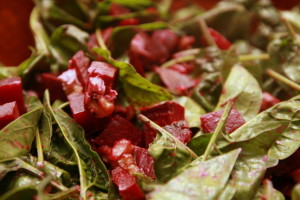
Roasted Beet Salad with Goat Cheese
1 / 4 cup balsamic vinegar
3 tablespoons shallots, thinly sliced
1 tablespoon honey
1/ 3 cup extra-virgin olive oil
Salt and freshly ground black pepper
6 medium beets, cooked and quartered
6 cups fresh greens (spinach, lettuce, arugula, etc.)
1 / 2 cup walnuts, toasted, coarsely chopped
3 ounces soft fresh goat cheese, coarsely crumbled
Line a baking sheet with tinfoil. Preheat oven to 450 degrees
Whisk the vinegar, shallots and honey in a medium bowl to blend. Gradually whisk in the olive oil. Season the vinaigrette to taste with salt and pepper. Toss the beets in a small bowl with enough dressing to coat. Place the beets on the prepared baking sheet, and roast until the beets are slightly caramelized, stirring occasionally, about 12 minutes. Set aside and cool.
Toss the greens and walnuts in a large bowl with enough vinaigrette to coat. Season the salad to taste with salt and pepper. Mound the salad atop four plates. Arrange beets around the salad. Sprinkle with goat cheese. Serve.
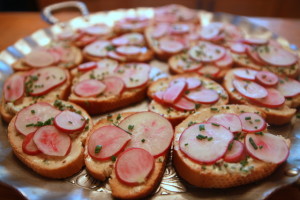
Radish Toast with Sesame-Ginger Butter
4 tablespoons butter, room temperature
3 tablespoons minced chives, divided
1 tablespoon toasted sesame seeds
3 / 4 teaspoon grated peeled fresh ginger
1 / 4 teaspoon Asian sesame oil
16 1 / 4-inch-thick baguette slices, lightly toasted
10 radishes, thinly sliced
Mix butter, 2 tablespoons chives, sesame seeds, ginger and sesame oil in small bowl; season with salt and pepper. Spread butter mixture over each bread slice. Top with radishes, overlapping slightly. Sprinkle with remaining chives.
Spinach Quiche
1 tablespoon butter
2 spring onions, minced
2 bunches spinach, thick stems removed and leaves roughly chopped
Coarse salt and ground pepper
4 ounces Gruyere or Swiss cheese, grated (about 1 cup)
1 frozen pie crust
4 large eggs
1 1 / 2 cups half-and-half
Dash of ground nutmeg
1 teaspoon salt
1 teaspoon pepper
Preheat oven to 350 degrees, with racks set in upper and lower thirds. In a large skillet, heat butter over medium. Add spring onions, and cook, stirring occasionally, until softened, 1 to 2 minutes. Add as much spinach to skillet as will fit; season with salt and pepper, and toss, adding more spinach as room becomes available, until wilted, 2 to 3 minutes.
Transfer spinach mixture to a colander. Press firmly with the back of a spoon to squeeze out as much liquid as possible. Sprinkle cheese onto crust. Spread spinach mixture over shredded cheese.
In a large bowl, whisk together eggs, half-and-half, nutmeg, 1 teaspoon salt and 1 teaspoon pepper. Pour egg mixture into crust.
Bake until center of quiche is just set, 55 to 60 minutes. Let quiche stand 15 minutes before serving.
Cover and refrigerate leftovers up to 1 day. Reheat at 350 degrees until warm in the center, 30 to 40 minutes.
Easy Kale Chips
Preheat oven to 350 degrees. Remove large central stem from kale leaves and tear into chip sized pieces. Drizzle with olive oil and add a sprinkle of salt or seasoned salt. Bake in the oven for 10-15 minutes until leaves edges are brown but not burnt.
Peas and New Potatoes
1 pound new potatoes
1 cup shelled peas
1 tablespoon butter
1 tablespoon flour
Salt and pepper to taste
1 cup milk or half & half
Bring a large pot of water to a boil over high heat. Boil potatoes for 15 to 20 minutes, until tender. Drain.
In a medium saucepan, bring 1 cup water to a boil. Simmer peas in boiling water for 6 to 7 minutes, or until tender (do not overcook). Drain.
Using the same saucepan, melt butter over medium heat. Stir in flour to make a thick paste; gradually whisk in milk, stirring constantly until slightly thickened. Season with salt and pepper to taste. Add potatoes and peas to the sauce; simmer for about 5 minutes, stirring often. Serve immediately.
Crisp Tuna-Cabbage Salad
One 5-ounce can tuna, drained
2 cups finely chopped green or red cabbage, from about 4 ounces or 1 / 4 of a small head of cabbage
1 tablespoon mayonnaise
3 tablespoons plain Greek yogurt
Salt and freshly ground black pepper
Shred the tuna with a fork and mix thoroughly with the cabbage. Stir in mayonnaise and yogurt. Add salt and pepper to taste. Eat immediately, or refrigerate for up to two days. Makes two 1-cup servings.
Basil Pesto
1-2 cups fresh basil leaves
2-4 cloves of garlic
3 / 4 cup good olive oil
1 / 2 cup grated Parmesan cheese
1 / 4 cup pine nuts or walnuts (opt.)
Put basil in blender or food processor. Add garlic, and blend, adding olive oil slowly. Add Parmesan and pine nuts. Blend all into a thick sauce.
This is good over any hot pastas. It can be also added to salad dressing, 1 tablespoon at a time, used as a spread for tomatoes, on crackers, etc. Pesto can also be frozen in small container for use later.
Green Bean and Pasta Salad
4 ounces penne pasta, uncooked (1 1/4 cups)
4 ounces green beans, halved crosswise (about 1 cup)
1 cup canned red or kidney beans, rinsed
1/4 cup chopped fresh flat-leaf parsley
2 tablespoons grated Parmesan (2 ounces)
2 tablespoons olive oil
2 tablespoons fresh lemon juice
Kosher salt and black pepper
Cook the pasta according to the package directions, adding the green beans during the last 3 minutes of cooking. Drain and run under cold water to cool.
Toss the cooled pasta and green beans with the red beans, parsley, Parmesan cheese, olive oil, lemon juice, 1 / 2 teaspoon kosher salt, and 1 / 4 teaspoon black pepper. Divide the salad between two containers and refrigerate for up to one day.
